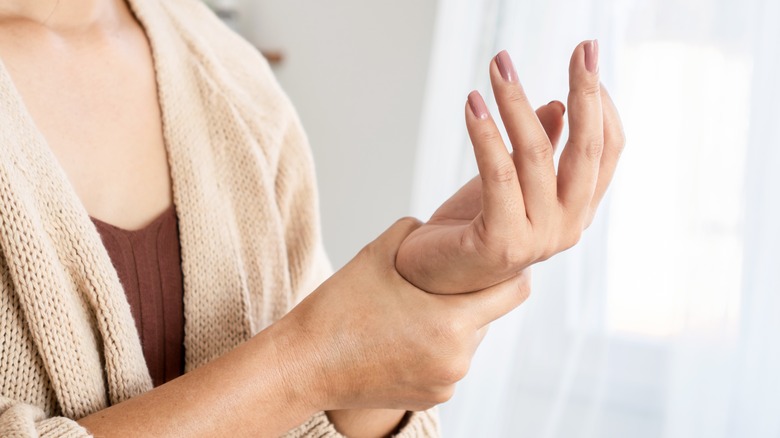What It Means When Your Finger Tips Turn White
Maybe winter is a hard time for you. Your fingertips turn white every time you step out into the cold weather. This might be a condition you've had since your teen years, or it could also be something you've just started to notice after your diagnosis of lupus. Having your fingertips turning white is a common condition known as "Raynaud's syndrome."
In Raynaud's syndrome, the blood doesn't flow properly to your hands and toes, sometimes even your ears and nose, according to the NHS. When a stimulus like cold or stress hits you, your blood vessels will abnormally constrict, reducing the blood flow into your fingers. So, when you step out the door on a wintery morning, your fingertips turn white. Sufferers can also experience pain, numbness, and a pins and needles feeling. Getting warm can help the symptoms, but you might be dealing with white fingertips for a few hours until the circulation picks back up.
Let's learn more about the different types of Raynaud's syndrome and how to prevent symptoms.
Primary vs. secondary Raynaud's syndrome
Like most conditions, there are different types of Raynaud's syndrome. The primary condition is more common and comes with milder symptoms, and it's typically called "Raynaud's disease" (via Mayo Clinic). It doesn't have a known cause. The symptoms are typically due to cold and go away once your body is all warmed up. Therefore, treatment of the primary form of this condition is to keep your body warm to avoid the symptoms.
Secondary Raynaud's is also known as "Raynaud's phenomenon" and is related to another health condition. According to the National Institute of Arthritis and Musculoskeletal and Skin Diseases (NIAMS), the secondary form can be more dangerous due to the severity of the symptoms. Possible conditions that cause this phenomenon are rheumatic diseases such as scleroderma or lupus. These conditions cause inflammation within the body that can damage smaller arteries. Illnesses that cause damage to the arteries (like artery disease) or pressure to nerves (like carpal tunnel) can also be to blame. It's not just diseases, though. Mayo Clinic also notes that certain medications might cause artery restriction making your fingertips turn white.
Risk factors associated with Raynaud's syndrome
Sleuthing out whether you have this condition can take doing a little research.
Secondary Raynaud's risk factors are pretty easy to ascertain. Getting diagnosed with scleroderma increases your risk of developing Raynaud's phenomenon by about 95%, according to the Circulation Foundation. Risk factors can also be found at your job and in your environment. Those who work with vibrations, like construction workers, can be at more risk of developing this secondary condition. Smoking or using specific chemicals, like vinyl chloride, also increases your chances.
But, if nothing is jumping out at you, then you need to consider your gender, age, and heredity since you may have the primary form of the condition. According to NIAMS, women tend to have this circulatory disease more than men, so estrogen might come into play. This is especially true if you're a woman younger than 30. While this disease doesn't typically start showing symptoms at birth, you probably began to notice it in your teen years. It's also been shown to run in families. If your mother or grandmother says it's completely normal and their fingers do it all the time when they get cold, chances are you've got it too.
Treatment and prevention of Raynaud's symptoms
The treatment of Raynaud's syndrome depends on the type that you've got.
Raynaud's phenomenon, the secondary form, requires you to treat your original condition to limit the disorder's symptoms. But it might not go away completely, especially when artery damage is high. Surgery and medications like vasodilators and calcium channel blockers can help with severe symptoms, according to the Mayo Clinic.
Those with the primary form of the condition don't typically require treatment since the symptoms ebb on their own once the fingers warm up. However, if possible, you might try taking a preventative stance to avoid the symptoms. Since Raynaud's syndrome symptoms are triggered by cold, keeping your hands and feet warm is essential. Invest in a good pair of gloves and insulated socks to wear whenever you're in or near cold. This includes touching refrigerated food or putting your hands in cold water. You might even want to consider using insulated glasses or koozies. Additionally, IPRS Health notes that exercising regularly and meditating can help get your blood flowing. It also suggests setting your air conditioner low and warming your car.




